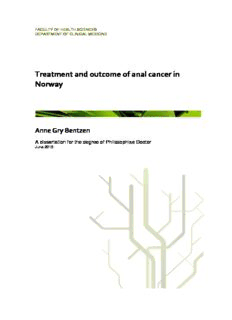
Treatment and outcome of anal cancer in Norway PDF
Preview Treatment and outcome of anal cancer in Norway
FACULTY OF HEALTH SCIENCES DEPARTMENT OF CLINICAL MEDICINE Treatment and outcome of anal cancer in Norway Anne Gry Bentzen A dissertation for the degree of Philosophiae Doctor June 2013 Treatment and outcome of anal cancer in Norway Anne Gry Bentzen, MD A dissertation for the degree of Philosophiae Doctor (PhD) at the University of Tromsø June 13th 2013 CONTENTS ACKNOWLEDGEMENTS ......................................................................................... 1 ABBREVIATIONS ................................................................................................. 3 LIST OF PAPERS ................................................................................................. 4 1 INTRODUCTION ............................................................................................ 5 2 BACKGROUND .............................................................................................. 7 2.1 Epidemiology ......................................................................................... 7 2.2 Anatomy, lymphatic drainage and staging ..................................................... 8 2.3 Treatment ........................................................................................... 12 2.3.1 Surgery ......................................................................................... 12 2.3.2 Radiotherapy .................................................................................. 12 2.3.3 Chemoradiotherapy .......................................................................... 13 2.3.4 Inguinal lymph node irradiation ........................................................... 16 2.3.5 Treatment time .............................................................................. 17 2.3.6 Salvage surgery ............................................................................... 17 2.4 Prognosis ............................................................................................. 17 2.5 Late effects ......................................................................................... 18 2.5.1 Reporting of late effects.................................................................... 20 2.6 Health-related quality of life ................................................................... 21 2.6.1 Assessment of HRQOL ....................................................................... 21 2.7 Neurotoxicity ....................................................................................... 23 2.8 Faecal incontinence ............................................................................... 23 2.8.1 Assessment of faecal incontinence ....................................................... 24 3 AIMS OF THE THESIS ................................................................................... 25 4 METHODS AND MATERIALS ............................................................................ 26 4.1 Patients .............................................................................................. 26 4.2 Treatment principles in Norway 2000-2007 ................................................... 27 4.3 Evaluation of treatment and definitions of endpoints ...................................... 31 4.4 Survivors ............................................................................................. 32 4.5 Volunteers ........................................................................................... 34 4.6 Assessment of long–term effects ................................................................ 35 4.6.1 HRQOL and neurotoxicity ................................................................... 35 4.6.2 Faecal incontinence ......................................................................... 36 4.7 Statistics ............................................................................................. 37 5 SUMMARY OF THE RESULTS .......................................................................... 39 5.1 Paper I................................................................................................ 39 5.2 Paper II ............................................................................................... 43 5.3 Paper III .............................................................................................. 45 6 DISCUSSION .............................................................................................. 47 6.1 Methodological considerations .................................................................. 47 6.1.1 Paper I ......................................................................................... 47 6.1.2 Papers II and III ............................................................................... 48 6.2 Discussions of results .............................................................................. 54 6.2.1 Optimization of chemoradiotherapy regimen ........................................... 54 6.2.2 Targeted therapy............................................................................. 56 6.2.3 Prognostic and predictive factors ......................................................... 56 6.2.4 Colostomy ..................................................................................... 57 6.2.5 Salvage surgery ............................................................................... 58 6.2.6 Identification, prevention and treatment of late effects ............................. 59 6.2.7 Increased focus on late effects and HRQOL ............................................. 60 7 CONCLUSIONS AND FUTURE PERSPECTIVES ....................................................... 62 REFERENCES ................................................................................................... 63 ERRATA ......................................................................................................... 75 PAPERS I-III APPENDICES ACKNOWLEDGEMENTS The work for this thesis was carried out at the Department of Oncology, University Hospital of North Norway and at the Institute of Clinical Medicine (IKM), University of Tromsø, from 2009-2013. The project was made possible by founding from the Northern Norway Regional Health Authority. Many people have been important to me during my years as a PhD student. First of all I would like to thank my supervisors. I think you have represented a dream team: I am greatly indebted to Lise Balteskard, my primary supervisor. You have been my mentor in oncology in the clinic and all the way through this project an excellent supervisor, full of enthusiasm and positive energy. Your constructive guidance, clear- thinking, resoluteness and encouragement have been invaluable, as well as your concern for my well-being. Thank you for always having time to discuss my work although I know you have a tight schedule. I am also deeply grateful to my co-supervisor, Marianne Grønlie Guren. Your scientific knowledge, your unique ability to convert my vague ideas into more concrete sentences and your constant positive attitude has been crucial. I would also like to express my gratefulness to my second co-supervisor, Barthold Vonen. Your scientific knowledge has been an important contribution, and your surgical approach has brought some counterweight into the female-oncologist-trio. Special thanks to my other co-authors Eva Hoff Wanderås, Gunilla Frykholm, Kjell Magne Tveit and Olav Dahl, who have contributed both with data collection and with critically reading and valuable suggestions to improve the manuscripts, and to Tom Wilsgaard for valuable contribution to the statistics. 1 Special thanks to the participants of this project who generously shared their experience. This project could not be performed without your contribution. I wish to thank the project staff Ann Nyheim, Ingrid Sandstad, and Kristine Talseth for excellent support with data collection. Warm thoughts go to all the nice colleagues at the department of oncology in Tromsø. I am grateful to Tone Nordøy, the head of the oncology department, for her support and willingness to facilitate of clinical work with this research project. I also want to thank Hege Sagstuen Haugnes for many constructive discussions and for friendship. I wish to thank my very good and close friend throughout my life, Elin Foshaug. Your wisdom coupled with your professional acquired psychiatric insights has provided many valuable suggestions and discussions on this project and on life in general. Warm thanks go to all my family, my parents, brother and sister for all support and care. My sister is deeply thanked for careful and patient proofreading of manuscripts, for fashion guidance and for helping her auntie-kids with homework. Finally and most of all, I want to thank my husband, Børge, for continuous support, for your love and for always being there for me, and our three children Henning, Iver, and Eline for all happiness and joy. Tromsø, March 2013 Anne Gry Bentzen 2
Description: